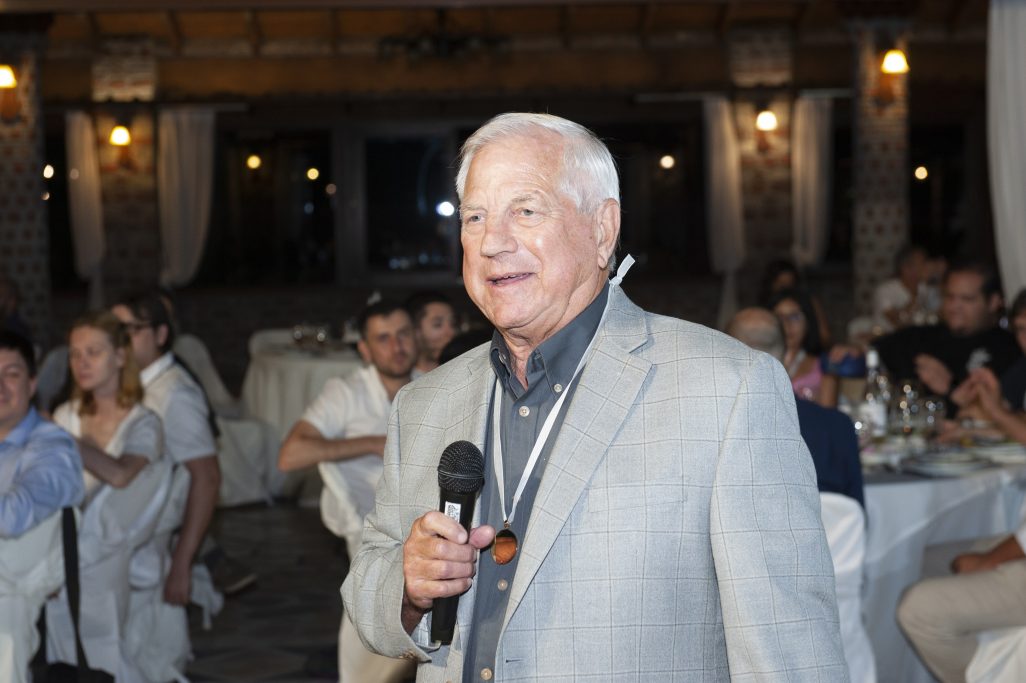Smith honored with IRC Gold Medal Award
Many in the atmospheric science community consider William L. Smith to be the father of satellite atmospheric sounding. The International Radiation Commission agrees.
This summer, Smith received the IRC Gold Medal Award, recognizing his contributions of lasting significance to the field of radiation research – contributions that have spanned more than 50 years.

Thessaloniki, Greece, July 4-8, 2022. Credit: IRC
“Bill’s leadership is largely responsible for the evolution of the satellite radiance observation framework and associated applications from their beginnings in the late 1960s to today,” writes Dave Tobin, distinguished scientist at the University of Wisconsin-Madison Space Science and Engineering Center who nominated Smith for the award.
Smith, who bears many titles, currently is a senior scientist at SSEC, professor emeritus at UW–Madison and distinguished professor at Hampton University. His trajectory has included leadership positions as a government scientist as well as university faculty. These connections have strategically positioned him to collaborate between and across organizations, facilitating the pipeline of ideas that migrate from university laboratories to government operations in the process.
From the earliest days of his career as a scientist in the National Oceanic and Atmospheric Administration’s Radiation Branch, Smith could see the possibilities inherent in satellite observations of the Earth’s atmosphere. He also recognized their limitations.
“Because I had developed the operational retrieval processing system, I soon realized that clouds were the major obstacle to atmospheric profile accuracy,” says Smith.
So, beginning with NASA’s NIMBUS 5 polar-orbiting satellite in the 1960s, Smith embarked on a path to design and build a radiometer with high horizontal resolution that could sample above and between clouds to accurately measure temperature and water vapor, especially of mesoscale features that range in size from several to several hundred kilometers. Such features, like thunderstorms, snowstorms or hurricanes had evaded understanding because there wasn’t an effective method of gathering detailed information about them. These early NIMBUS radiometers led to the first high resolution and accurate temperature and water vapor data that established a baseline for forecasting and studying these storms.
By 1975, Smith was leading the development of a scanning radiometer – the High-resolution Infrared Radiation Sounder – that flew on Nimbus 6 the same year. Like its predecessor, the instrument delivered vertical measurements of temperature and water vapor, but with even greater precision. The HIRS flew on NOAA operational satellites for 40 years.
The Nimbus experiments marked the beginning of Smith’s quest to uncover new information about the vertical structure of the atmosphere. In doing so, he joined forces with colleagues at SSEC to help refine the ground-based Atmospheric Emitted Radiance Interferometer and the aircraft-based High-resolution Interferometer Sounder to improve vertical temperature and water vapor measurements from those instruments – measurements that have been vital to validating the accuracy of satellite measurements for several decades.
“As Bill envisioned, radiance observations from the HIS, and the AERI, demonstrated the measurement concepts that have led to today’s international constellation of Low Earth Orbit satellites that now carry hyperspectral sounders,” says Tobin.
The lineage is clear and direct: These include the U.S. Cross-track Infrared Sounder on Suomi NPP and NOAA-20 developed by Smith and colleagues as a replacement for the HIRS, the European Space Agency’s Infrared Atmospheric Sounding Interferometer on the Met-Op series of satellites and the Chinese Meteorological Agency’s Hyperspectral Infrared Atmospheric Sounder on the Feng-Yun series of polar orbiting satellites. Not only are these sensors crucial as data sources for numerical weather forecasts, they are providing information on greenhouse gases and Earth’s changing climate.
Smith’s work with polar-orbiting instruments and sensors has been balanced by, and often conducted in tandem with, pioneering work on geostationary radiance observations since the 1970s. In fact, success of the airborne HIS – and collaborative enhancements to it over three decades with partners at NASA and SSEC – produced a prototype instrument known as the Geostationary Imaging Fourier Transform Spectrometer. GIFTS demonstrated that it was possible to gather hyperspectral radiance measurements from geostationary orbit.
While the U.S. has not launched such a sounder on its satellites, international partners, recognizing the myriad applications of precise temperature, moisture and winds data in the horizontal and vertical domains as well as over time, have adopted the measurement technique for their own geostationary satellites. The Geostationary Interferometric Infrared Sounder or GIIRS, on CMA’s Feng-Yun–4D and -4E satellites are already in orbit and returning data. They will be followed in 2023 by the InfraRed Sounder on the EUMETSAT-European Space Agency’s Meteosat Third Generation-S geostationary satellite.
Smith exhibits the same enthusiasm today as he has throughout his career, an enthusiasm that continues to lead to improvements in weather forecasting through innovations in the science of measurement technology. He has his sights set on, and is demonstrating the potential value of, a new US satellite system known as Geostationary Extended Observations that will include a hyperspectral sounder and is slated to launch within the next decade.
“My many mentors, students and colleagues with whom I’ve worked over six decades have made these accomplishments possible,” says Smith. “We’ve had an amazing ride.”
Read more about Bill Smith in this 2016 story from SSEC News: https://www.ssec.wisc.edu/news/articles/8720
